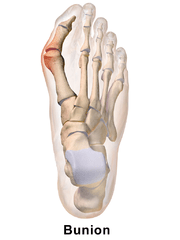
24 Nov Bunionectomy: Expert Care and Recovery
A bunion is a deformity of the foot caused by the big toe turning inwards toward the other toes. Bunions occur at the joints and can be extremely painful due to the weight of your body resting on the it during normal walking. In addition, inflammation, irritation, and calluses can form due to an untreated bunion. Patients may or may not feel symptoms at first but repeated stress on the foot will eventually make them more pronounced.
The surgery to remove a bunion is called a bunionectomy and the procedure falls into two separate categories. A head procedure bunionectomy is the first type and involves the bone being cut behind the joint, moved to its proper position, and fixed in place with a screw or a pin. Base procedures concentrate on the bone near or behind the big toe joint, and there are a variety of different procedures based on the deformity.
The specialists at Cherrywood Foot Care have a deep understanding of the biomechanics of each patient’s foot as well as years of experience with the intricacies of the bunionectomy procedure. Bunion surgery can reduce or eliminate the bone deformity, improve foot alignment and function, and prevent damage to other toes, but it does have its limitations. While a bunionectomy will remove the source of the pain, there is no guarantee that it will not come back. On top of surgery, you might also need to spend time in physical therapy or a corrective orthotic device on an ongoing basis.
Bunion surgery is usually performed at a hospital or surgical center and takes a half a day to a day for the full procedure. You will not be able to eat or drink anything the night before the surgery and you should wash your feet the morning of the procedure. Following the surgery, you will be prescribed pain medication and may have to walk with crutches or wear a surgical shoe as the foot needs to be kept elevated as much as possible.
Surgical sutures are removed about two weeks after the surgery and normal activities can be resumed, although you will have to continue to wear a dressing on the infected area. By the fifth week following surgery, you should already be doing physical exercises and initiated a physical therapy program if necessary. The specialists at Cherrywood Foot Care will be there to guide you through the bunionectomy process and get you back walking on your feet!

